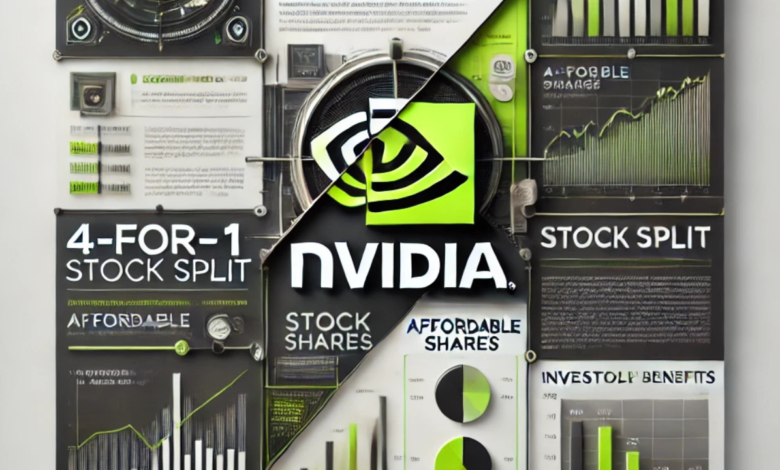Everything You Need to Know About the NVDA Stock Split A Comprehensive Guide

NVIDIA Corporation (NASDAQ: NVDA) is a technology sector leader known for its cutting-edge graphics processing units (GPUs) and AI advancements. Among the topics frequently discussed by investors and market analysts is the NVDA stock split. This corporate action has significant implications for shareholders, potential investors, and the company. In this comprehensive guide, we’ll delve into the details of NVIDIA’s stock splits, their history, how they work, and what they mean for the market.
What Is a Stock Split?
A stock split occurs when a company increases the number of its outstanding shares by issuing more to its current shareholders. This corporate action does not affect the company’s overall market capitalization but reduces the stock price, making shares more accessible to a broader range of investors.
For example, in a 4-for-1 stock split, an investor holding one share valued at $800 would now own four shares worth $200 each. The total value remains unchanged, but the reduced share price can boost trading activity and attract more retail investors.
NVIDIA’s Stock Split History
NVIDIA has conducted several stock splits since its initial public offering (IPO) in 1999. Here’s a brief overview:
- June 27, 2000: 2-for-1 stock split.
- September 17, 2001: 2-for-1 stock split.
- April 7, 2006: 2-for-1 stock split.
- July 20, 2021: 4-for-1 stock split.
The most recent stock split in 2021 significantly reduced the stock price, making it more appealing to individual investors while maintaining its overall valuation. This move came during a period of solid growth for NVIDIA, driven by demand for GPUs and AI technology.
Why Do Companies Like NVIDIA Opt for Stock Splits?
Companies like NVIDIA opt for stock splits for several reasons:
- Improved Accessibility: A lower stock price makes shares more affordable for retail investors, increasing market participation.
- Enhanced Liquidity: A more significant number of shares in circulation can lead to higher trading volumes.
- Market Perception: A stock split signals confidence in the company’s growth, often attracting new investors.
- Alignment with Competitors: Stock splits can keep a company’s share price competitive compared to industry peers.
What Happened During NVIDIA’s 2021 Stock Split?
NVIDIA’s 4-for-1 stock split on July 20, 2021, was a landmark event. Here’s what happened:
- Pre-Split Price: NVIDIA’s stock traded at approximately $750 per share.
- Post-Split Price: The price was adjusted to around $187.50 per share.
- Shareholder Impact: For every share owned pre-split, investors received four shares of equal value.
This move was part of NVIDIA’s strategy to attract a broader investor base amid surging demand for GPUs, AI technologies, and cryptocurrency mining hardware.
How Does a Stock Split Impact Investors?
While a stock split doesn’t change the intrinsic value of an investment, it does have several implications for investors:
- Accessibility for New Investors: Lower share prices can make the stock more attractive to smaller investors.
- Portfolio Adjustments: Existing shareholders may need to rebalance their portfolios after receiving additional shares.
- Psychological Impact: A lower price often creates a perception of affordability, increasing demand.
- Dividend Adjustments: The per-share dividend amount may be adjusted accordingly if the company pays dividends.
Market Reaction to NVIDIA Stock Splits
Historically, NVIDIA’s stock splits have been met with positive market reactions. For instance, the announcement of the 2021 stock split coincided with a rise in share price due to increased investor interest and optimism about the company’s growth prospects. Stock splits are often viewed as a sign of confidence in future performance, which can boost investor sentiment.
Should You Buy NVDA After a Stock Split?
Investing in NVIDIA after a stock split depends on your investment goals and market conditions. Here are a few factors to consider:
- Fundamentals: NVIDIA’s financial performance, product pipeline, and market leadership are critical factors.
- Valuation: While stock splits make shares cheaper, evaluating whether the stock is overvalued or reasonably priced is essential.
- Growth Potential: NVIDIA’s role in AI, gaming, and data centers positions it as a strong growth candidate.
Before investing, conduct thorough research and consider consulting a financial advisor.
Future of NVDA Stock Splits
With NVIDIA’s impressive track record of innovation and market leadership, future stock splits are possible if the share price climbs significantly again. Companies often use splits as a tool to manage share price and market accessibility, and NVIDIA is likely to continue this practice as part of its long-term strategy.
Key Takeaways
- NVIDIA has executed four stock splits since its IPO, the most recent being a 4-for-1 split in 2021.
- Stock splits make shares more affordable without altering the company’s valuation.
- NVIDIA’s stock splits have historically been followed by positive market reactions, signaling investor confidence.
- Future stock splits will depend on NVIDIA’s share price performance and growth trajectory.
FAQs About NVDA Stock Split
1. What is the primary purpose of NVIDIA’s stock split?
The primary purpose is to make NVIDIA’s shares more affordable for retail investors, increase liquidity, and enhance market participation.
2. How does a stock split affect existing shareholders?
Existing shareholders receive additional shares in proportion to the split ratio. Their holdings’ total value remains the same, but the price per share decreases.
3. Did NVIDIA’s 2021 stock split change the company’s valuation?
No, a stock split does not impact the company’s overall valuation or market capitalization. It merely divides the existing shares into smaller units.
4. Is NVIDIA likely to perform another stock split in the future?
While there is no guarantee, NVIDIA may consider future stock splits if its share price increases significantly again.
5. How can investors benefit from a stock split?
Investors benefit from increased share affordability, enhanced liquidity, and the psychological appeal of a lower stock price, which can attract more market participants.
This comprehensive guide provides a detailed understanding of NVIDIA’s





